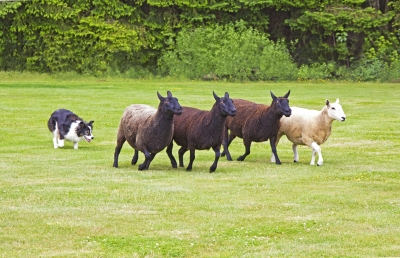Sheepdog Syndrome
Today, we introduce Rob Trenckmann’s first post as a regular contributor to the LeaderTreks blog. He currently serves in Hungary with Josiah Venture, and has a wealth of insight to offer youth workers and their teams. Here, he shares his thoughts on that horrifying moment when leaders transform from patient visionaries into rabid canines (and a few ways to tame that tendency). –Kyle Rohane, Editor at LeaderTreks
I was afraid I had lost the whole group. Not physically—thankfully!—but as a team. They were the most frustrating group of student leaders I’ve ever had. We were in the middle of a summer full of whitewater rafting camps and leadership training, and they were content to sit on the sidelines while others did the work of engaging, serving, and leading.
Again and again, I pulled them aside and challenged them to step out of their comfort zones. Again and again, I made them aware of their selfish, small-minded ways. But nothing seemed to help. We were at a stalemate. I had a mutiny on my hands. And I had no idea how to turn the ship.
Have you ever been there? Have you led a group that was derailed by a group of students who simply wouldn’t respond? Have you dug to the bottom of your “bag of tricks,” only to come up empty?
Maybe you’re prepping for a short-term mission trip, but your team of students won’t prepare spiritually. No matter how much you warn, challenge, or rebuke, their hearts stay hard. (Yep, I’ve been there.)
Maybe you’re on a camp or retreat and you’re spending so much time tracking down rumors and putting out fires that you don’t have time to do your real job. (Been there, too.)
Maybe you’re working with a brand new group of students, and you’re desperate for them to know the power of Christ’s love and to experience living on mission with him—and all you get in return are bored, blank stares. (That one really frustrates me.)
It’s in those moments that I turn into a sheepdog. Full of frustration at their apathy or unbelief, I find myself nipping at their heels, chasing strays, chastising stragglers, and barking at the disobedient. You know you’re in “sheepdog” mode when you:
- Try to write a lesson, but find yourself planning the whole thing around one person.
- Notice rising anger levels in your rebuke.
- Begin to cross social and relational lines you wouldn’t normally cross, trying to provoke them to respond.
- Become consumed with what isn’t working.
- Try to push the group forward into spirituality by the force of your position or personality.
Of course “sheepdog syndrome” is more than a set of symptoms. It shows the heart-condition of a leader. Lacking vision for the group, or losing hope in their ability to grow, you take it upon yourself to force the student or group to change. This strategy rarely, if ever, works—especially if your goal is lasting change.
God doesn’t call us to be sheepdogs; he calls us to be shepherds. The shepherd of old always led from the front. Not from the front facing his flock, trying to show them his authority. And not from the back, trying to force them to go his way. Instead, he was in the front, facing forward, saying, “Come this way. Walk where I walk. Go where I go. Come with me.” It’s a posture of vision and forward thinking.
When our leadership moves from sheepdog to shepherd, everything changes. We go from nipping at heels to blazing trails. Specifically:
- Instead of focusing on the stragglers, we give our time and attention to those who are really ready to go. This shift in attention changes the whole group culture.
- Instead of emphasizing what is going wrong, we begin to champion what is going right.
- Instead of furthering the stalemate of rebuke and unresponsiveness, we start a cycle of positivity and progress that sweeps others along.
- Instead of producing hard hearts or, at best, short-term change, we speak to the hearts and character of our students and see lasting transformation.
That’s what I had to do with that group of student leaders. Partway through the summer, I realized I was being a sheepdog, and I needed to be a shepherd. And worse, my posture was contagious—it had spread to our entire team. So I gathered the adult leaders together and explained the situation. Together, we committed ourselves to leading from the front with vision and by example. And it changed the atmosphere of the summer.
I still get tempted to lead like a sheepdog sometimes. A student won’t respond, or a young person is defiant, or a group won’t engage, and I want nothing more than to snarl and bite. But I’m quicker than I used to be at stopping those instincts and choosing to be a shepherd instead.
How about you? When are you tempted to lead as a sheepdog? What implications do you see from God’s example as a shepherd?
About the Author
Guest Contributor
The LeaderTreks Blog is proud to share the hard-earned wisdom of student ministry leaders from many different backgrounds and professions. From time to time, we will feature guest blog posts from writers other than our regular contributors. We include these posts to provide additional perspectives and insight that we’re sure will help develop you and your ministry… Read More





